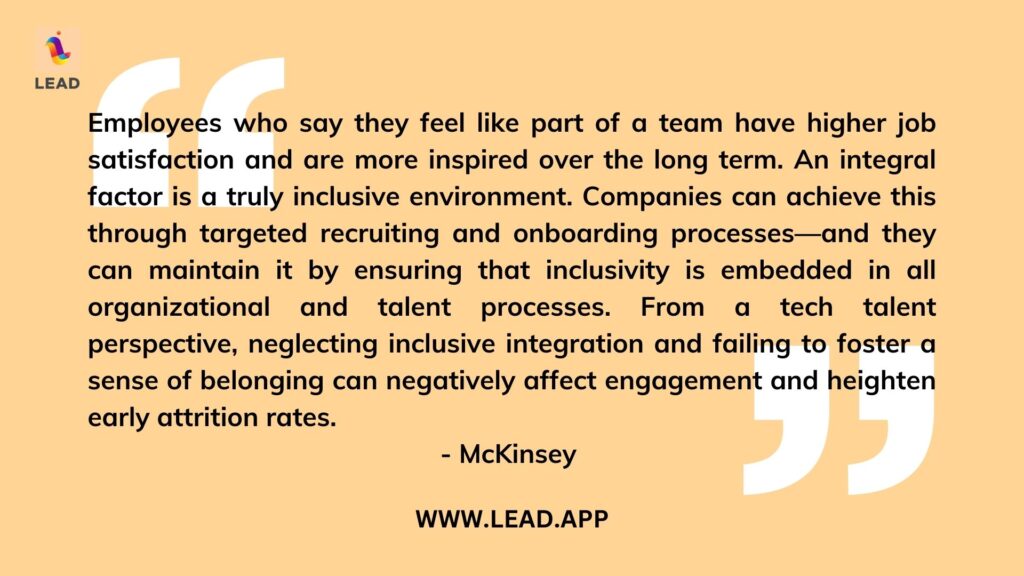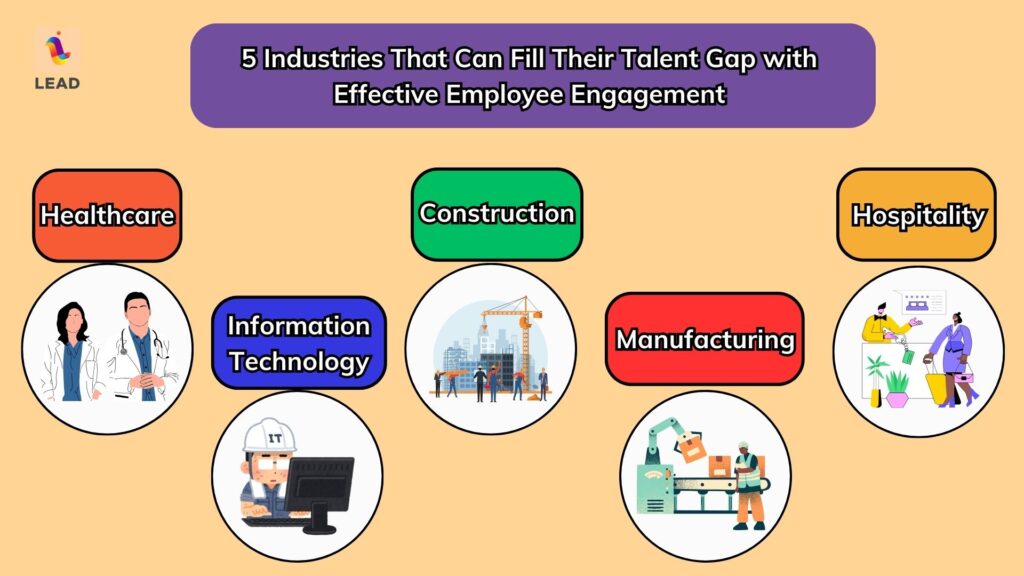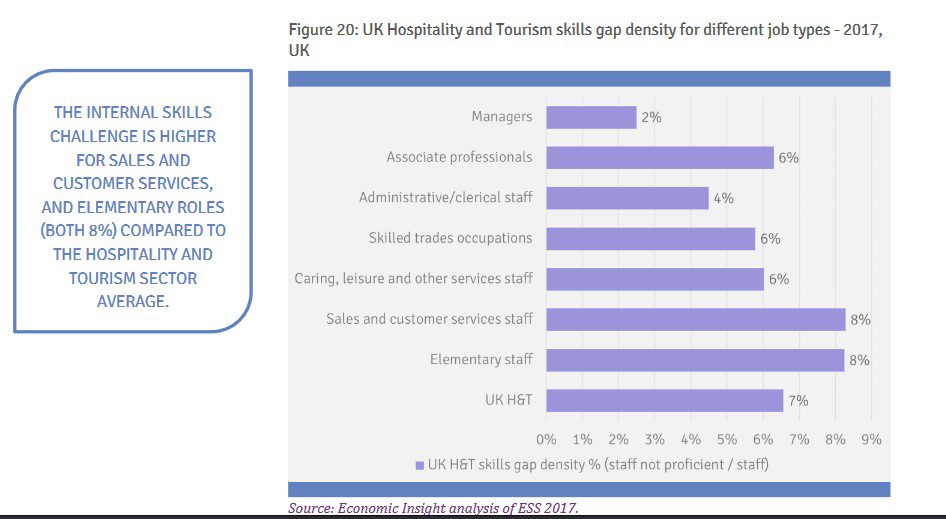Gen Z hiring has become something of a meta topic for managers that is redefining the entire professional working landscape. Companies are increasingly discovering that they cannot simply put up competitive packages and get good talent into their fold. Gen Z is prioritizing employee engagement, career growth, work flexibility, and networking opportunities over a bumped-up salary. And some industries like industrial manufacturing and IT are feeling the skill gap pinch more than others.
The answer to all their problems, however, is already available and the leading companies are implementing them as we write this. It’s called employee engagement and it is the new way to boost business productivity and develop organizational growth. Over time and with advanced new hire onboarding practices, companies also stand to attract higher-value talent with a strong employee engagement reputation.
With that in mind, let’s look at the five biggest industries where employee engagement stands to change the face of the business if applied effectively:
How Employee Engagement Will Transform These Five Major Industries
Healthcare
Key Takeaways:
-
A lot of doctors and medical staff have experienced burnout and healthcare organizations are facing shortages because of it.
-
In the next decade, the US Bureau of Labor Statistics estimates a shortage of 200,000 U.S. nurses, and the Association of American Medical Colleges projects a gap of up to 124,000 physicians.
-
Healthcare executives can fill skill gaps and address burnout by fostering collaboration based work cultures which reduce stress and burnout while developing skills in direct practice.
The US healthcare industry has been facing a shortage of skilled workers for some time now. With the global pandemic, the US healthcare system faced an unprecedented challenge. It left a lot of people unable to carry on with regular employment after the pandemic ended. A lot of doctors and medical staff have experienced burnout and healthcare organizations are facing shortages because of it. Now that new public health alerts like monkeypox are out, getting the right skills on premises will be a top priority for hospitals and other medical institutions.
According to this article in Forbes,
Nearly 50% of physicians have experienced burnout, and 20% have experienced depression, highlighting vulnerability within the workforce. Additionally, in the next decade or so, the Bureau of Labor Statistics estimates a shortage of nearly 200,000 U.S. nurses, and the Association of American Medical Colleges projects a gap of up to 124,000 physicians.
How Does the LEAD bot Help Solve this Problem?
LEAD bot is a dedicated cross-team collaboration, knowledge-sharing, and employee engagement app. Part of its AI-supported process involves enabling mentorship. From direct to P2P mentoring and many others, it offers several options to healthcare HR executives for developing in-house talent. Studies have shown that mentoring also reduces stress and burnout among professionals while developing skills in direct practice. Further, managers in healthcare businesses can use its watercooler features to create a better and more supportive work culture. Automated channel posts help people connect over common conversation topics and also develop a knowledge-sharing-based culture.

McKinsey quote on tech talent skill gaps and employee work culture inclusivity
Information Technology
Key Takeaways:
-
IT executives are mostly looking inward to address talent gaps while the parameters for how people get selected are changing towards hands on skills.
-
It’s about raising operational efficiency and creating a workforce that can cascade up with relevant talent pools.
-
Companies can achieve this through targeted recruiting and onboarding processes—and they can maintain it by ensuring that inclusivity is embedded in all organizational and talent processes.
The sheer volume of IT demand in the US market is staggering. And while every globally competent IT developer or engineer wants to go to the US, executives are mostly looking inward to address talent gaps. Moreover, the parameters for how people get selected are also changing. It is more about hands-on skills that drive productivity than it was in the past when you had to have a university degree. And it makes sense to do so when the entire structure of the IT market is being reshaped by thought leaders and magnates like Bill Gates and Elon Musk. At the end of the day, it’s about raising operational efficiency and creating a workforce that can cascade up with relevant talent pools.
According to this article by McKinsey
Employees who say they feel like part of a team have higher job satisfaction and are more inspired over the long term. An integral factor is a truly inclusive environment. Companies can achieve this through targeted recruiting and onboarding processes—and they can maintain it by ensuring that inclusivity is embedded in all organizational and talent processes. From a tech talent perspective, neglecting inclusive integration and failing to foster a sense of belonging can negatively affect engagement and heighten early attrition rates.
How Does LEAD bot Help Solve this Problem?
LEAD bot is designed with work culture development and cross-team collaboration in mind. It fosters a dynamic working culture with its employee engagement activities like virtual coffee chats and watercooler sessions. It helps create unsiloed groups and its people science features help managers discover and nurture talent. For example, using LEAD bot to foster connections enables managers to create groups where the nerd mindset and core IT upskilling are fast-tracked. Meanwhile, breaking silos enables the creation of inter-bracket connections and skills that may enable those employees to grow managerial skills or specializations in tandem.
Construction
Key Takeaways:
-
Construction-industry executives stand to develop highly specialized workforce talent and on the other, they may lose big if they do not.
-
Technology is moving fast while skill uptake remains varied particularly because of automation and the growth of the digital logistics and EV market.
-
For the US and global construction market, the need is greatest for creating specialized skill and talent pools.
The US construction industry is currently experiencing a workforce surplus. And this is a problem since technology is moving fast while skill uptake remains varied. Thanks to automation coming into the picture and new industries like EVs coming up there is a lot of market volatility. But this is both a problem as well as an opportunity. On one hand, executives stand to develop highly specialized workforce talent and on the other, they may lose big if they do not.
According to this document by the U.S. Chamber of Commerce,
On the contrary, the construction industry faces a labor surplus. The number of unemployed workers with experience in this industry exceeds the available job openings, with an average of 383,917 job vacancies per month in 2023, while the monthly average of individuals with experience in this field seeking employment amounts to 480,333.
It’s worth noting that a labor surplus does not ensure that all positions will be occupied, as workers may not necessarily be located in the geographic areas where the open positions are situated. It also does not imply that an industry will have all the workers it needs in future years.
So, the writing on the wall is clear. Construction companies must develop the requisite skill enhancement plans to keep up with both market demands and tech frontiers. In addition, Gen Z has shown a lot of interest in going back to hardware industries like construction. But their needs differ from the previous generations in that they want better culture and growth opportunities.
How Does LEAD bot Help Solve this Problem?
LEAD bot is foremost an employee engagement and mentoring platform. In that way, it is perfect for creating work cultures that center around productivity-based skill development. For the US and global construction market, the need is greatest for creating specialized skill and talent pools. Developing mentoring programs that enable both older and Gen Z workers to grow their skills offers the best chance for lasting talent pools that may even become inter-generational.

5 Industries That Can Fill Their Talent Gap with Effective Employee Engagement
Manufacturing
Key Takeaways:
-
Process industries are competing for a scarce talent pool that hasn’t traditionally considered careers in manufacturing and is hard to attract to remote locations.
-
Without things like specific new hire onboarding sessions and other career-oriented benefits, they may drop the company within a year and even in a few weeks.
-
Virtual coffee chats and watercooler sessions are a good way to build team collaboration. Along with custom mentoring options especially for Gen Z workers.
Manufacturing sectors worldwide are facing some pretty uphill climb conditions. They are seeing the rise of tech-centric, digitally-defined work environments. While Gen Z is able to fill the gap made by the retiring workers, they do have specific needs and those are top priorities for managers. Without things like specific new hire onboarding sessions and other career-oriented benefits, they may drop the company within a year and even in a few weeks.
According to this article by BCG,
“The current workforce challenge will be further exacerbated for process industries as we enter a decade that will see “the great retirement wave”–companies are unable to maintain the required replacement rate, which will further impact productivity”, said Karthik Valluru, BCG partner and managing director, and co-author of the report. “Process industries are competing for a scarce talent pool that hasn’t traditionally considered careers in manufacturing and is hard to attract to remote locations. Getting serious about workforce planning is crucial to navigating this increasingly dynamic and competitive talent market.”
How Does LEAD bot Help Solve this Problem?
LEAD bot is designed to enable managers to pursue a variety of employee engagement activities. At the same time, the app is highly customizable for how they want to use the features. Virtual coffee chats and watercooler sessions are a good way to build team collaboration. Meanwhile, custom mentoring options, something very important for Gen Z and new hire onboarding, enable them to develop talent which also ensures job safety in a volatile market.
Hospitality
Key Takeaways:
-
Workers in a soft skills segment like hospitality not only want to have job security but also a culture they can bank on.
-
Since every hospitality industry business has its own culture and aesthetics to front itself on, developing custom employee mentoring programs is essential.
-
Unlike something task or process-oriented, these training modules must be person and brand-oriented.
The hospitality industry in both the US and the Western European markets took a big hit during the pandemic. And now, there is a growing skill-shortage that threatens to loom heavy on these economies. In both internal and external tourism and hospitality, the UK in particular, is in need of highly-skilled professionals. Developing these talent pools is a matter of creating the right working culture and organizational health. Workers in a soft skills segment like hospitality not only want to have job security but also a culture they can bank on. Check the image below to see where the hospitality industry is missing talent the most.

UK hospitality industry skill gaps and employment opportunities
How Does LEAD bot Help Solve this Problem?
LEAD bot is capable of creating custom employee engagement and mentoring scenarios. This is one of the biggest assets managers can get from the app. Since every hospitality industry business has its own culture and aesthetics to front itself on, developing custom employee mentoring programs is essential. Unlike something task or process-oriented, these training modules must be person and brand-oriented. In enabling this, LEAD bot offers a unique value proposition to hospitality managers, particularly thanks to its AI-supported engagement and learning modules.
How Should Your Business Pursue its Employee Engagement and Productivity Development Activities?
All the five industries we have mentioned above are creating new challenges as they grow. Their workforce populations face the biggest threat in not managing to uptake the emerging technology and falling out of favor from lack of client engagement. The surest way to address this problem and those specific to each industry lies in creating work culture dynamics that appropriately address these demands. This is where LEAD bot holds the answers.
LEAD bot is a team engagement platform for big businesses and MNCs on Slack and Teams. It is an all-in-one team development software with features like virtual coffee chats, buddy programs, birthday celebrations & work anniversary celebrations, new hire onboarding programs, and Pulse Surveys.
LEAD bot also offers cutting-edge Organizational Network Analysis (ONA) for large-scale organizations.
C-suite execs and mid-level managers benefit greatly in their decision-making from ONA and use its highly actionable insights for building strong connections across their workforce. This enables far more forward-leaning talent development and generates greater organizational interconnectedness! Foster better organizational health, talent development, employee retention, and overall performance with this simple app!
LEAD.bot is a product of LEAD.app and we also LEAD.bot’s sister app Sunrize which showcases workplace attendance by graphs right on Slack! Book a demo now!







